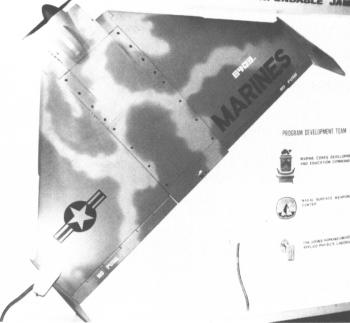Applied Physics Lab Air-Exjam
The Air-Exjam (Airborne Expendable Jammer) drone was developed by APL in collaboration with the U.S. Naval Surface Weapons Center. It was to show the feasibility of a low-cost expendable mini-drone for jamming or other EW (Electonic Warfare) tasks, and flew for the first time in early 1982.
The Air-Exjam was a flying-wing delta design powered by a small two-cylinder two-cycle piston engine. It took-off and landed on conventional runways, but parachute/airbag recovery was also possible. The drone was preprogrammed to fly to a selected target area by dead reckoning, and the range to that area was determined by a preset amount of revolutions of an air-driven impeller. Once over the target area, a small RF transmitter was dropped to the ground, and the drone went into loitering mode. The Air-Exjam was also fitted with a radio command control system for remote piloting of the vehicle.
 |
| Photo: Terry J. Gander |
| Air-Exjam |
Seven Air-Exjam drones were built, and the flight test program ended at the end of 1983. The Air-Exjam itself was not immediately further developed, but the vehicle apparently led to the BQM-147 Exdrone UAV for the U.S. Marine Corps.
Specifications
Data for Air-Exjam:
| Wingspan | 2.03 m (6 ft 8 in) |
| Weight | 18.1 kg (40 lb) |
| Speed | 177 km/h (110 mph) |
| Endurance | 3 h |
| Propulsion | Two-cycle piston engine; 2.2 kW (3 hp) |
Main Sources
[1] Kenneth Munson: "World Unmanned Aircraft", Jane's, 1988
Back to Directory of U.S. Military Rockets and Missiles, Appendix 4
Last Updated: 5 May 2004